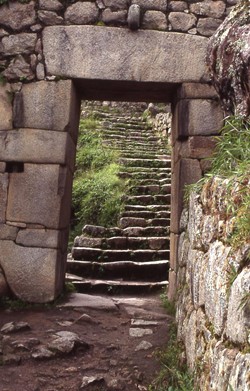[
{
"name": "Top Stories Video Pair",
"insertPoint": "7",
"component": "17087298",
"parentWrapperClass": "fdn-ads-inline-content-block",
"requiredCountToDisplay": "1"
}
]
One of the mysteries of ancient civilizations, for me, is why it took so long for engineers of old to figure out the true arch. All buildings need openings for doorways and windows. The earliest and simplest way to span an opening is with a lintel, a flat piece of stone or wood or, nowadays, metal. For ancient people, wood often wasn't available, and it rotted. Steel hadn't been invented, which left stone. Stone is usually really strong in compression, but weak in tension. That is, if you stretch it, as happens with the part of the stone on the underside of a lintel, it's subject to cracking, limiting the width of the opening.
The ancient Egyptians had another trick up their sleeves. The pyramids are essentially big -- very big -- tombs, so they had to have some way of creating rooms deep inside the pyramids large enough to accommodate a stone sarcophagus, or coffin. Take the largest pyramid, Cheops: Right in the center of the huge structure is the King's Chamber, a hollow space about 36 feet long by 18 feet wide. (Curiously, archeologists believe that the huge granite sarcophagus found there was never used.) Above the chamber are hundreds upon hundreds of tons of limestone blocks bearing down -- far too much weight for a stone lintel to support across the width of the chamber. So the Egyptians used a corbel system, with successive layers of stone placed closer and closer together forming an inverted-V ceiling. Later, the Incas, Mayans and Aztecs used the same device whenever they wanted to span more than a few feet.
Although the odd attempt had been made earlier, it wasn't until the Roman Empire that we see the full flowering of the successor to the lintel and corbel: the arch. Note that all the individual stones, or voisseurs, are compressed, thus taking advantage of the ability of stone and brick to resist compression. Unlike a corbel arch, where each side is freestanding, a true arch would collapse if you removed part of it. So to construct one, the Romans first built a wooden form in the shape of the arch's underside, on which each individual voisseur was positioned, until they reached the keystone at the top. With that last piece of the puzzle firmly in place, the formwork was removed and the arch stayed up on its own. Note that a true arch pushes outwards, as well as down, so the abutments need to be sufficiently stable to support both the vertical weight and the outward force. As I say, it seems so obvious; I wonder why earlier civilizations, such as the Mesopotamians, didn't hit on it.
Although the Romans focused on the round arch, many variations are possible, all of which avoid putting the stone, or brick, into tension. For instance, the designers of the 13th and 14th century Gothic cathedrals of northern Europe found the pointed Gothic arch more to their taste. And although it's not built of stone or brick, St. Louis' stainless steel Gateway Arch, with its "inverted weighted catenary" profile, takes arch-building to the ultimate for efficiency, not to mention grace.
Barry Evans ([email protected]) marvels that 2,000-year old Roman arches still stand today.
Comments (4)
Showing 1-4 of 4
more from the author
-
A Brief History of Dildos
- Apr 11, 2024
-
Eclipse!
- Mar 28, 2024
-
The Little Drone that Could
- Mar 14, 2024
- More »
Latest in Field Notes
Readers also liked…
-
Trouble on the Line: The Reality Part 2
- Nov 3, 2022

































